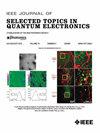评估极端热条件下的辐射冷却纺织品
IF 5.1
2区 工程技术
Q1 ENGINEERING, ELECTRICAL & ELECTRONIC
IEEE Journal of Selected Topics in Quantum Electronics
Pub Date : 2025-03-05
DOI:10.1109/JSTQE.2025.3567021
引用次数: 0
摘要
全球变暖需要节能的热管理解决方案,辐射冷却已经成为建筑和可穿戴应用的一种有前途的策略。尽管取得了重大进展,但这些材料在极端高温条件下的功效仍未得到充分探索。在这里,我们展示了基于玻璃纤维(GF),碳纤维(CF)和凯夫拉尔(KV)的被动辐射日间冷却(PDRC)涂层的高性能纺织品,集成了优越的光学,热学和机械性能。我们的实验表明,这些纺织品具有较高的太阳反射率(93- 97%)和红外发射率(95- 96%),与棉花相比,在阳光下平均冷却8.3°C。此外,这些涂层纺织品提供卓越的耐用性,在各种环境压力下保持性能,降解最小。分析建模与实验测试相结合,进一步强调了高近红外反射率在火灾等高温环境中的关键作用,为扩展其在个人防护设备、应急可穿戴设备和极端条件下的结构热管理中的适用性提供了重要见解。本文章由计算机程序翻译,如有差异,请以英文原文为准。
Assessing Radiative Cooling Textiles for Extreme Thermal Conditions
Global warming necessitates energy-efficient thermal management solutions, and radiative cooling has emerged as a promising strategy for buildings and wearable applications. Despite significant advancements, the efficacy of these materials under extreme heat conditions remains underexplored. Here, we present passive radiative daytime cooling (PDRC) -coated high-performance textiles based on glass fiber (GF), carbon fiber (CF), and Kevlar (KV), integrating superior optical, thermal, and mechanical properties. Our experiments demonstrate that these textiles achieve high solar reflectivity (93--97%) and infrared emissivity (95--96%), enabling an average of 8.3 °C of cooling under sunlight compared to cotton. Additionally, these coated textiles offer exceptional durability, maintaining performance under various environmental stressors with minimal degradation. Analytical modeling, combined with experimental testing, further underscores the critical role of high near infrared reflectance in high-temperature environments like fire, providing important insights for extending their applicability to personal protective equipment, emergency wearables, and structural thermal management in extreme conditions.
求助全文
通过发布文献求助,成功后即可免费获取论文全文。
去求助
来源期刊

IEEE Journal of Selected Topics in Quantum Electronics
工程技术-工程:电子与电气
CiteScore
10.60
自引率
2.00%
发文量
212
审稿时长
3 months
期刊介绍:
Papers published in the IEEE Journal of Selected Topics in Quantum Electronics fall within the broad field of science and technology of quantum electronics of a device, subsystem, or system-oriented nature. Each issue is devoted to a specific topic within this broad spectrum. Announcements of the topical areas planned for future issues, along with deadlines for receipt of manuscripts, are published in this Journal and in the IEEE Journal of Quantum Electronics. Generally, the scope of manuscripts appropriate to this Journal is the same as that for the IEEE Journal of Quantum Electronics. Manuscripts are published that report original theoretical and/or experimental research results that advance the scientific and technological base of quantum electronics devices, systems, or applications. The Journal is dedicated toward publishing research results that advance the state of the art or add to the understanding of the generation, amplification, modulation, detection, waveguiding, or propagation characteristics of coherent electromagnetic radiation having sub-millimeter and shorter wavelengths. In order to be suitable for publication in this Journal, the content of manuscripts concerned with subject-related research must have a potential impact on advancing the technological base of quantum electronic devices, systems, and/or applications. Potential authors of subject-related research have the responsibility of pointing out this potential impact. System-oriented manuscripts must be concerned with systems that perform a function previously unavailable or that outperform previously established systems that did not use quantum electronic components or concepts. Tutorial and review papers are by invitation only.
 求助内容:
求助内容: 应助结果提醒方式:
应助结果提醒方式:


